Constellation families are groups of constellations that are either located in the same area of the sky, associated with the same myth or theme, or were created at the same point in history. Most northern constellations are associated with myths and were originally listed by Ptolemy in his Almagest in the 2nd century AD. The far southern constellations, on the other hand, which were invisible to the Greeks, were introduced between the 16th and 18th centuries, when explorers started travelling south and charting the southern sky.
Constellation families as we know them today were defined by Donald H. Menzel, theoretical astronomer, astrophysicist and director of the Harvard Observatory in the 1950s and 1960s. In his best-selling A Field Guide to the Stars and Planets (1975), Menzel used traditional and historic groups of star constellations and organized them into eight families to make it easier for stargazers to remember where they are located.
Menzel’s constellation families are: Ursa Major Family, Zodiac Family, Perseus Family, Hercules Family, Orion Family, Heavenly Waters Family, Bayer Family and Lacaille Family.
URSA MAJOR FAMILY
The Ursa Major Family consists of 10 constellations located in the vicinity of Ursa Major and the north celestial pole. Other than Ursa Major and Ursa Minor, the group includes Draco, Boötes, Camelopardalis, Canes Venatici, Coma Berenices, Corona Borealis, Lynx and Leo Minor. All these constellations lie in the northern celestial hemisphere. Ursa Major, Ursa Minor and Draco are circumpolar to northern observers, i.e. they never set below the horizon and can be seen throughout the year. As they circle the north celestial pole, they are mostly invisible to observers in the southern hemisphere.
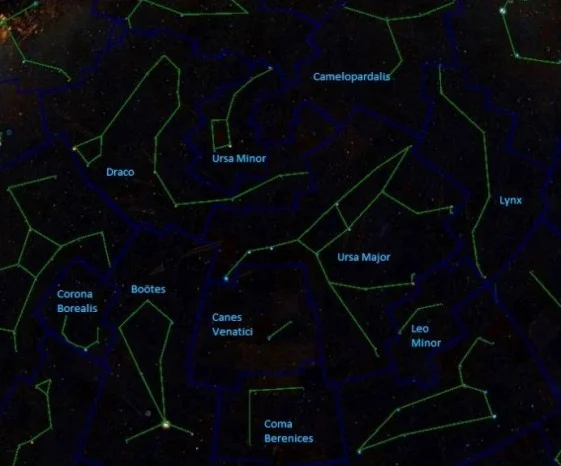
Constellations in the Ursa Major family, image: Wikisky
ZODIAC FAMILY
The Zodiac Family consists of the 12 zodiac constellations: Pisces, Aries, Taurus, Gemini, Cancer, Leo, Virgo, Libra, Scorpius, Sagittarius, Capricornus and Aquarius. These are constellations along the ecliptic, the path that the Sun appears to follow over the course of a year. There is another constellation that lies on the ecliptic – Ophiuchus – but it is not traditionally seen as part of the zodiac circle and belongs to the Hercules Family.
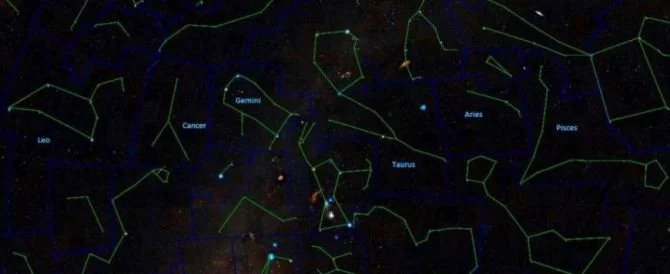
Constellations in the zodiac family: Leo, Cancer, Gemini, Taurus, Aries and Pisces, image: Wikisky
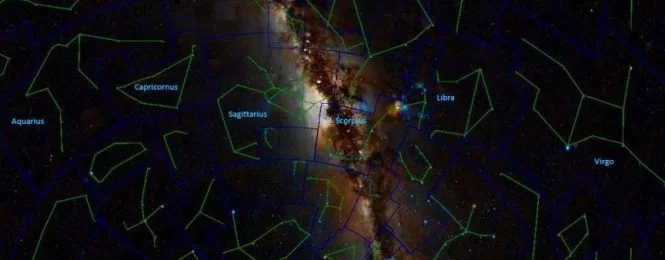
Zodiac constellations: Aquarius, Capricornus, Sagittarius, Scorpius, Libra and Virgo, image: Wikisky
PERSEUS FAMILY
The Perseus Family includes the constellations associated with the myth of Perseus – Perseus, Andromeda, Cassiopeia, Cepheus, Cetus and Pegasus – and several constellations located in the vicinity: Auriga, Lacerta and Triangulum. The last three were added to the traditional group by Menzel because of their location in the sky. All these constellations except Cetus lie in the northern sky.
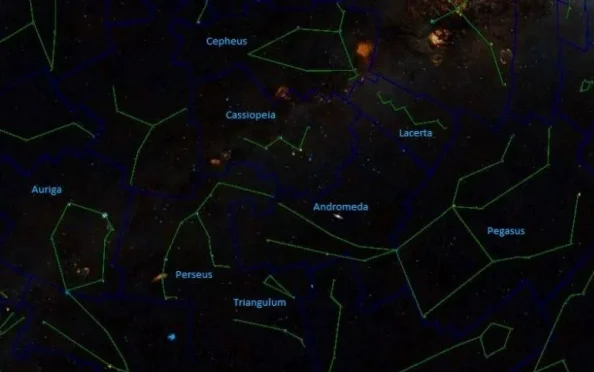
Perseus family of constellations, image: Wikisky
HERCULES FAMILY
The Hercules Family is based mainly on proximity. It is the largest of the eight groupings, consisting of 19 constellations located mostly in the western sky. The constellations that belong to this group are Hercules, Aquila, Lyra, Sagitta, Cygnus, Vulpecula, Sextans, Hydra, Corvus, Crater, Serpens, Ophiuchus, Centaurus, Scutum, Ara, Corona Australis, Lupus, Triangulum Australe and Crux. They occupy a vast area of the sky that stretches from latitude 60°N to 70°S.
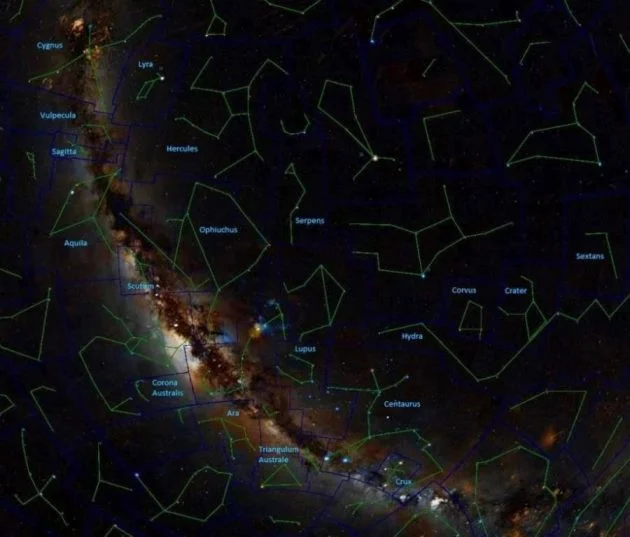
Hercules family of constellations, image: Wikisky
ORION FAMILY
The Orion Family, the smallest of the eight groups, consists of the five constellations associated with the myth of Orion, the Hunter: Orion, Canis Major, Canis Minor, Lepus and Monoceros. The group, representing Orion and his two dogs chasing the hare, is found on the opposite side of the sky to the Hercules Family. Monoceros, the Unicorn, is not related to the myth, but Menzel added it to this group because it is situated between the four other constellations.
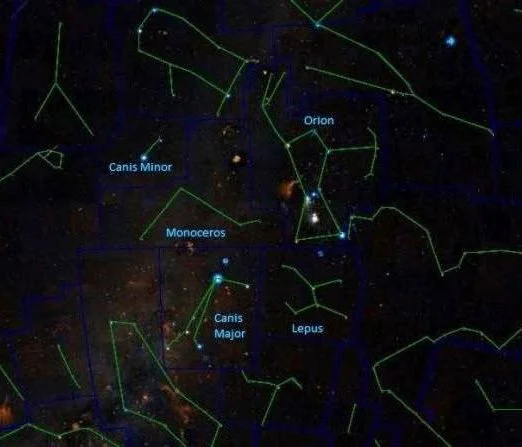
Orion family of constellations, image: Wikisky
HEAVENLY WATERS FAMILY
The Heavenly Waters Family contains nine constellations associated with water: Delphinus, Equuleus, Eridanus, Piscis Austrinus, Columba, Pyxis, Carina, Puppis and Vela. The last three constellations used to form Argo Navis, a Greek constellation that represented the ship of Jason and the Argonauts.
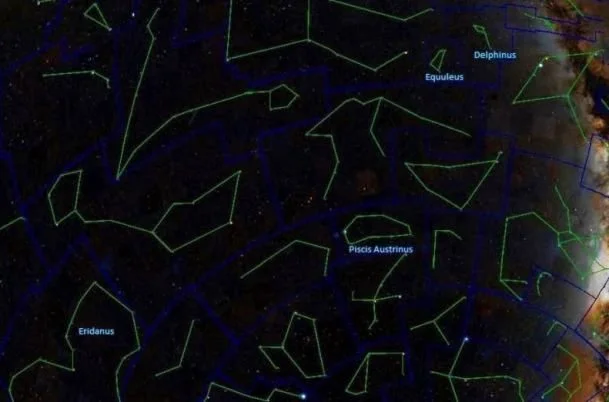
The northern part of the Heavenly Waters family, image: Wikisky
This grouping is based on the Mesopotamian tradition that associated the region of the sky between the constellations Sagittarius and Orion with Ea, the god of water, and the Waters of the Abyss. The zodiac constellations Aquarius, the Water Bearer, and Capricornus, the Sea Goat, are located in this area and associated with water, but as they already belong to the Zodiac Family, Menzel did not assign them to this group.
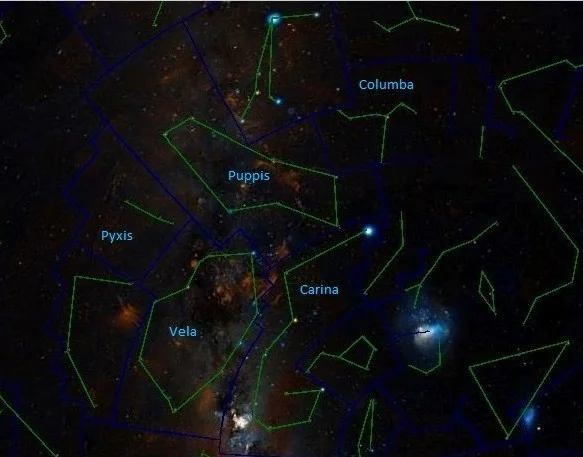
The southern part of the Heavenly Waters family, image: Wikisky
BAYER FAMILY
The Bayer Family consists of the constellations created by the Dutch-Flemish astronomer Petrus Plancius in the late 16th century based on the observations of Dutch explorers Pieter Dirkszoon Keyser and Frederick de Houtman. These constellations were first depicted in Johann Bayer’s celestial atlas Uranometria in 1603. They are located near the south celestial pole and represent the exotic animals explorers would encounter on their journeys.
The constellations in this group are Apus, Hydrus, Dorado, Volans, Pavo, Grus, Phoenix, Indus, Tucana, Musca and Chamaeleon. Bayer called Musca “Apis” (the Bee), but the name was later changed to Musca (the Fly). The constellations Phoenix, Tucana, Pavo and Grus, representing the phoenix, the toucan, the peacock and the crane, are collectively known as the Southern Birds.
The only constellation that was originally introduced in Bayer’s atlas that does not belong to this family is Triangulum Australe, which Menzel placed in the Hercules Family.
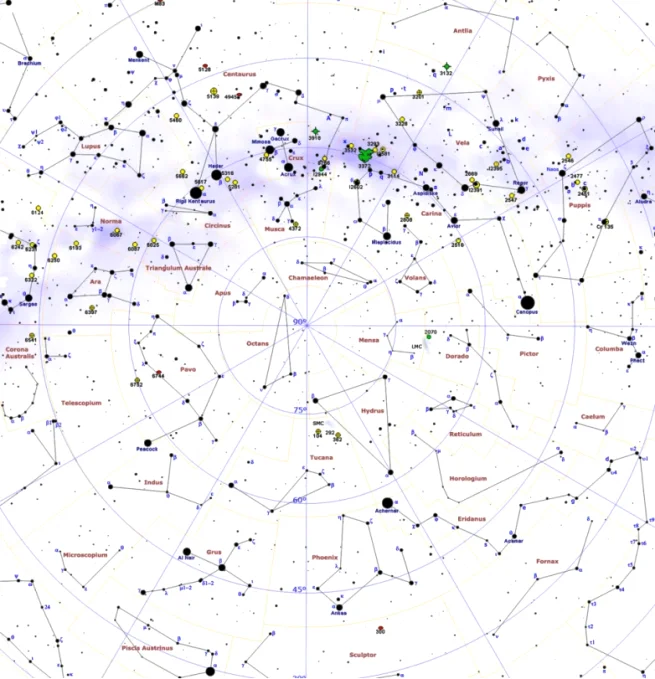
Constellations in the Bayer and Lacaille families, image: Roberto Mura
LACAILLE FAMILY
Similarly, the Lacaille Family includes almost all the constellations created by the French astronomer Nicolas-Louis de Lacaille in the 18th century: Norma, Circinus, Telescopium, Fornax, Sculptor, Microscopium, Horologium, Reticulum, Caelum, Mensa, Octans, Pictor and Antlia. These are mostly faint and small constellations in the far southern sky, representing various scientific instruments. Mensa represents Table Mountain (Mons Mensae) in South Africa, where Lacaille made his observations.
The constellation Pyxis, representing the mariner’s compass, was also created by Lacaille, but Menzel assigned it to the Heavenly Waters group. The compass is associated with Argo Navis constellation even though it was not a part of it. It represents the ship’s compass.
| URSA MAJOR FAMILY | ZODIAC FAMILY | PERSEUS FAMILY | HERCULES FAMILY |
| Ursa Major | Pisces | Perseus | Hercules |
| Ursa Minor | Aries | Cassiopeia | Sagitta |
| Draco | Taurus | Cepheus | Aquila |
| Canes Venatici | Gemini | Andromeda | Lyra |
| Boötes | Cancer | Pegasus | Cygnus |
| Coma Berenices | Leo | Cetus | Vulpecula |
| Corona Borealis | Virgo | Auriga | Hydra |
| Camelopardalis | Libra | Lacerta | Sextans |
| Lynx | Scorpius | Triangulum | Crater |
| Leo Minor | Sagittarius | Corvus | |
| Capricornus | Ophiuchus | ||
| Aquarius | Serpens | ||
| Scutum | |||
| Centaurus | |||
| Lupus | |||
| Corona Australis | |||
| Ara | |||
| Triangulum Australe | |||
| Crux | |||
| ORION FAMILY | HEAVENLY WATERS FAMILY | BAYER FAMILY | LACAILLE FAMILY |
| Orion | Delphinus | Hydrus | Norma |
| Canis Major | Equuleus | Dorado | Circinus |
| Canis Minor | Eridanus | Volans | Telescopium |
| Lepus | Piscis Austrinus | Apus | Microscopium |
| Monoceros | Carina | Pavo | Sculptor |
| Puppis | Grus | Fornax | |
| Vela | Phoenix | Caelum | |
| Pyxis | Tucana | Horologium | |
| Columba | Indus | Octans | |
| Chamaeleon | Mensa | ||
| Musca | Reticulum | ||
| Pictor | |||
| Antlia |